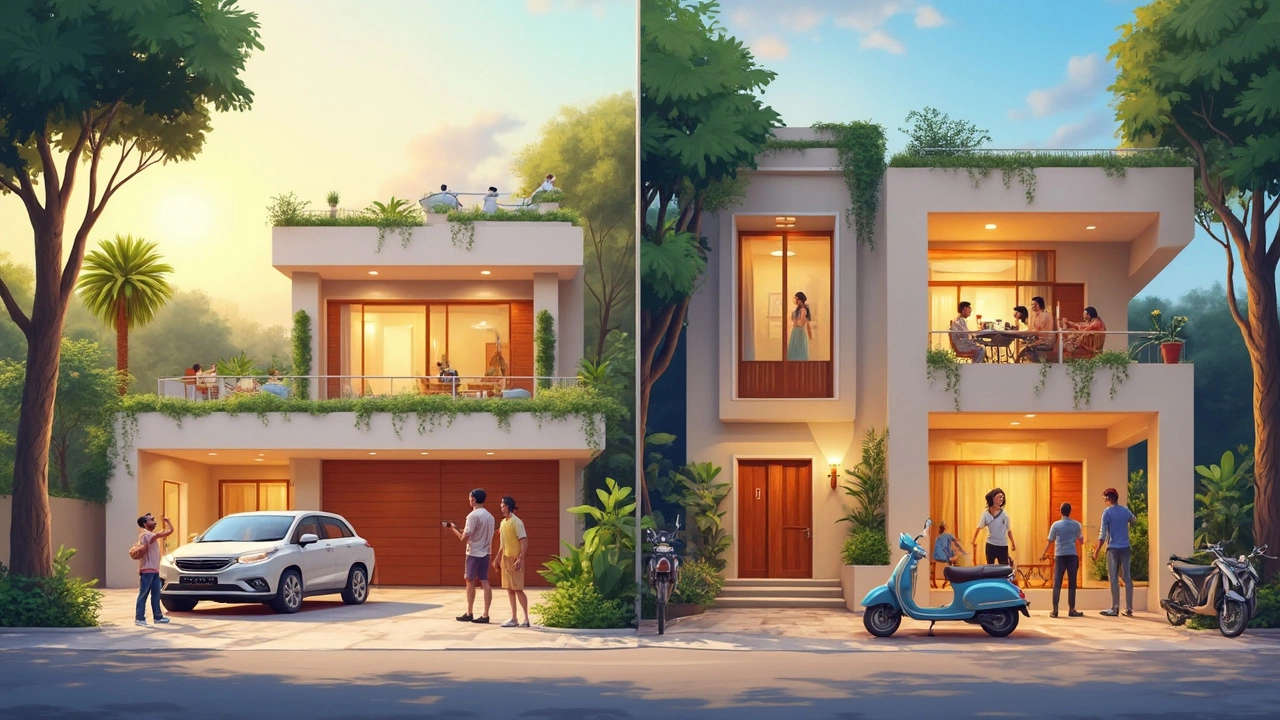Villa vs Duplex: Key Differences, Pros, and Cons Explained

Jul, 2 2025
Ever toured a "dream home" and been stumped by fancy real estate words? If you’re not sure what sets a villa apart from a duplex, you’re not alone. These terms pop up everywhere—from online listings to dinner table debates—but they’re often blurred by marketing talk and local habits. So, before anyone corners you about what you’d pick, let’s cut through the confusion.
What Exactly is a Villa?
Catch the word "villa" and you might imagine sun-soaked mansions or sprawling estates. That’s not just Hollywood talking. The origin of the villa goes all the way back to Ancient Rome, where wealthy citizens would escape the city for countryside retreats—complete with gardens, big open-air courtyards, and elegant columns. Fast-forward to 2025: a villa still screams luxury, but its real meaning depends a lot on where you are and who you ask.
In many parts of the world, a villa is a standalone house, usually found in gated communities or fancy neighborhoods. Think of homes with private lawns, backyards, maybe even a pool, and always space on all sides. No shared walls here. The vibe is exclusive, private, and designed for people who want peace or room for a growing family—or simply for showing off at the next barbecue.
Floor space is a key bragging point. According to a 2024 report from Global Housing Insights, the average villa in the US suburbs covers about 2,800 square feet, while luxury villas in places like Dubai or Spain often start at 3,500 square feet. You usually get:
- Two or more floors, but always your own private entrance
- Ample parking
- Private or semi-private gardens
- High-end finishes and open layouts
Of course, all that space and privacy come with a bigger price tag. Maintenance is entirely your job (unless you move to a gated community that bundles lawn care and security). Security can be top-notch if you pick a gated enclave. And because villas often sit in prime locations, they’re considered a solid investment. As of last year, villas in suburban hotspots appreciated by nearly 11%—outpacing many other residential types.
One interesting bit: in India and other parts of Asia, "villa" can also mean a high-end townhouse or row home—not always detached from neighbors. But wherever you are, expect villas to promise space, style, and some level of separation from the masses.
Understanding the Duplex: Design, Space, and Lifestyle
Now let’s switch gears. If villas look like the quiet, posh kid in class, the duplex is the practical multitasker always balancing two things at once—literally. The term "duplex" means double. It usually refers to a building with two separate living spaces, either side by side (like mirror images) or one atop the other (stacked floors), each with its own entrance. In most cases, one chunk of land holds two homes, sharing at least one wall.
An important point: in the United States, a duplex is a single building divided into two units. In other regions, the word gets mixed up with "semi-detached" or "twin homes," but the basic formula holds. They share a wall but not always much else. Some families buy a whole duplex—living in one unit and renting the other, a practical way to offset a mortgage or house extended family. A 2022 study by the American Housing Association found that duplexes make up almost 13% of new builds in urban and suburban areas, thanks to rising land prices and growing multigenerational households.
Duplexes are about compromise but not sacrifice. You still get your own kitchen, laundry, and yard space. They can look like two-story homes split down the middle, or a ground-floor unit with another upstairs, sometimes called "up-and-down" duplexes. No crowding in hallways or waiting for elevators, and you don’t have the same density as apartment blocks.
What’s inside? Typically, each unit measures about 1,100 to 1,800 square feet, with two or three bedrooms. Shared costs for exteriors or the roof make them cheaper to maintain than a full villa. That’s a major win for budget-conscious buyers. Here’s a handy comparison:
| Feature | Villa | Duplex |
|---|---|---|
| Number of Homes | One | Two (within one building) |
| Wall Sharing | None | At least one shared wall |
| Space (avg sq ft) | 2,800+ | 1,100–1,800 (per unit) |
| Privacy | High | Moderate |
| Ownership | Single | One or both units owned |
| Maintenance | Owner (sometimes shared in gated) | Usually shared |
| Yard/Garden | Yes | Often, but smaller |
| Investment Value | High, especially in premium locations | Steady, especially in cities |
Investors and first-time buyers love duplexes. Lower entry costs, the option to earn rental income, and a footprint that usually feels more "house" than "apartment". They fit city spaces, growing suburbs, or anyone looking to blend privacy and affordability.
Still, privacy is the main trade-off. Shared walls might mean you’ll hear a neighbor’s party on Saturday night or their early-morning blender. Rules for renovations can get dicey if you own just one unit. But for the price, most people are happy to take the compromise.
For anyone weighing the investment, the National Multifamily Housing Council reported in late 2023 that duplexes in mid-tier urban zones showed a 7% rent rise, outpacing apartments but sitting just behind standalone villas. They’re not just for families, either—young professionals and downsizers are getting in on the duplex trend.

The Big Differences: Villa vs Duplex, Side by Side
So what’s the real, tangible difference besides the real estate lingo? When it comes down to lifestyle, they truly are a world apart. Villas win hands-down for space, outdoor living, and customization. Need a backyard big enough for a soccer game? Go villa. Want to host birthdays or firepits without debating neighbors about noise? Villa, every time.
Duplexes offer flexibility and are often the only practical step up from an apartment for city dwellers. They work great if you want a little yard but don’t have the budget for a big land plot. If you’re getting into real estate as an investor or need space for aging parents, the duplex ticks both boxes—affordable and multi-use.
Location plays a big role. Villas are usually in quieter suburbs or exclusive gated zones, away from heavy street buzz. Duplexes pop up everywhere but thrive in places where land prices squeeze out the chance for roomy villas. In high-density cities, duplexes often deliver that "house" feel without the million-dollar sticker shock.
Homeowners have different rules and rights. If you own a whole villa, you can repaint the shutters pink or plant banana trees—no one’s stopping you. Duplex owners sometimes need approval from their neighbor or share upkeep of driveways, really requiring good cooperation. Developer rules and HOA policies (if any) make a difference here, so always check those paperwork piles before deciding.
Want a quick checklist? Here’s what to keep in mind:
- Dreaming of ultimate privacy or a custom-designed garden? That’s villa territory.
- Thinking about steady rental income, or splitting your property between family members? A duplex does the trick.
- Weighing maintenance routine: full responsibility (villa) or shared costs (duplex)?
- Looking for future value? Villas tend to appreciate faster in hot suburbs, while duplexes are safer bets in rising urban areas.
The best way to decide? Spend a weekend touring both. Step into a villa—notice the silence, the space, and the sense of "yours only." Compare it to a duplex—appreciate how smart layouts give everyone enough breathing room while keeping life affordable. Your choice isn’t just about square footage; it’s about what fits your day-to-day living style.
"A home isn’t just a building—it's a reflection of the lifestyle you want to lead. Villas offer privacy and freedom; duplexes deliver community and smart investment." – Sarah Addison, Architect, Home Life Magazine Interview, 2024
Tips for Choosing Between a Villa and a Duplex
Alright, you know the facts—so how do you actually choose? It’s less about dictionary definitions, more about what matters most to you or your family. Here are some tried-and-tested tips from real homeowners and property pros:
- Budget Wisely: Villas demand higher upfront costs—not just purchase price, but also ongoing maintenance and possibly bigger insurance bills. Duplexes are lighter on your wallet for both buy-in and monthly expenses.
- Think Long-Term: If you’re planning to grow your family or crave upgrades down the road (think play rooms, home offices, or extra garages), a villa’s space and flexibility can’t be beat.
- Rental Potential: Duplexes shine as investment properties. You can live in one unit and rent the other, or lease both for consistent income. Villas, meanwhile, attract high-paying tenants—if you’re willing to rent out the whole place.
- Future Resale: Check appreciation trends in your target neighborhood. Data from Redfin’s housing index shows villas in popular resort towns climbed in value by 14% in 2024. Meanwhile, duplexes in city outskirts grew by 7%—not shabby, but worth thinking about if resale value matters to you.
- Noise and Privacy: Be honest about your tolerance for shared walls or close neighbors. It’s a real factor, especially for light sleepers or anyone working from home.
- Maintenance Commitment: Not everyone likes mowing lawns or handling repairs solo. Duplexes allow you to team up—and maybe even split costs—for roof work, gutter cleaning, or landscaping.
- Location, Location, Location: If you need daily access to city centers, work, or schools, sometimes a duplex in a central spot beats a villa in the far burbs. Commuting time can change your opinion fast.
- Community and Security: Villas in gated communities offer round-the-clock security and often social perks like clubhouses or tennis courts. Duplexes can be more embedded in vibrant neighborhoods with lots of social buzz.
If you’re still not sure, talk to both villa and duplex owners. A neighbor’s tips or a walk-through on a busy Saturday can show you things no real estate brochure will mention. Ask about heating bills, how often repairs come up, what living next to a wall-sharer feels like—these are details that make or break your comfort.
Both options have massive fans and plenty of success stories. Whether you go big with a villa or choose the balanced approach of a duplex, make sure your decision fits your habits—not just your wishlist. That’s the real difference between being house proud and house frustrated. No bad choices, just honest ones.